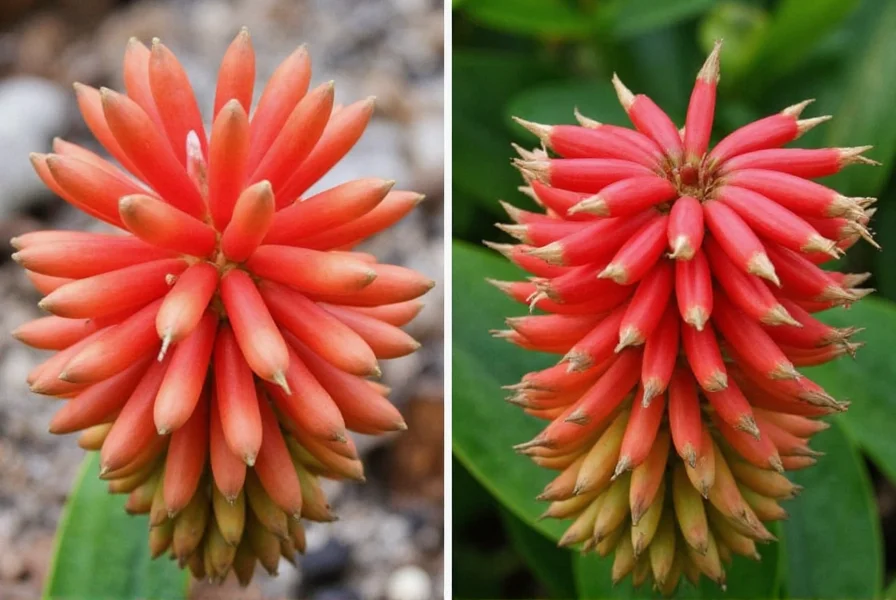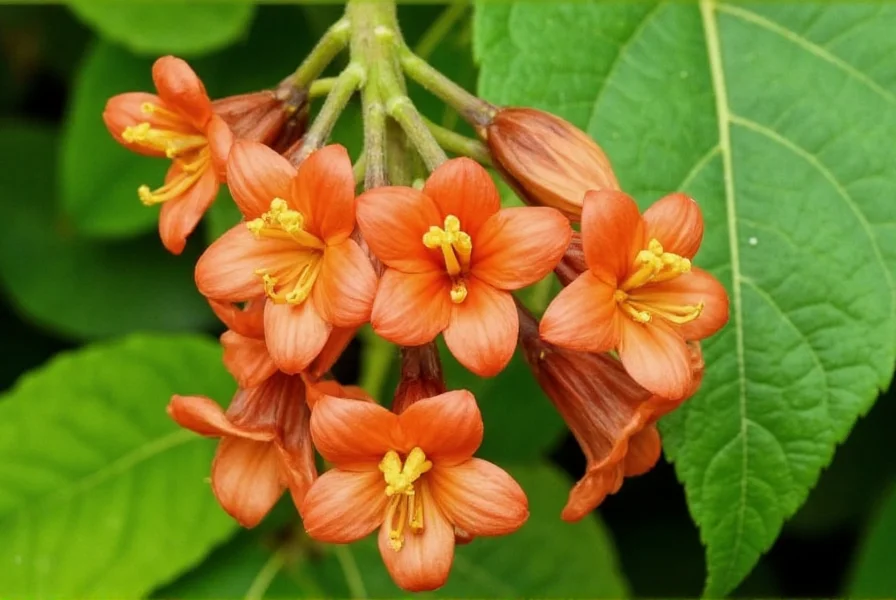While many people associate ginger solely with the knobby rhizome used in cooking and medicine, numerous ginger species produce spectacular flowers that make them prized ornamental plants in tropical and subtropical gardens. These botanical marvels represent nature's artistry within the ginger family, offering visual appeal far beyond the culinary root most consumers recognize.
Understanding Ginger Flower Biology
Ginger flowers develop from specialized structures called inflorescences that emerge from pseudostems formed by tightly wrapped leaf sheaths. The actual flowers grow within colorful bracts that protect the developing blooms. Each ginger flower typically features:
- A prominent lip or labellum that serves as a landing platform for pollinators
- Three outer sepals and three inner petals fused into a tube
- A single functional stamen with pollen-producing anthers
- A hidden pistil containing the ovary
This unique floral architecture has evolved to attract specific pollinators like bees, butterflies, and hummingbirds in their native tropical ecosystems. The intricate relationship between ginger flowers and their pollinators demonstrates remarkable co-evolution in plant reproduction strategies.
| Ginger Variety | Flower Color | Flowering Season | Height |
|---|---|---|---|
| Hedychium coronarium (White Ginger) | Pure white with yellow center | Late summer to fall | 3-8 feet |
| Alpinia purpurata (Red Ginger) | Bright red bracts | Year-round in tropics | 6-14 feet |
| Curcuma alismatifolia (Siam Tulip) | Pink, purple, or white | Summer to fall | 1-3 feet |
| Zingiber officinale (Culinary Ginger) | Rarely flowers in cultivation | Spring | 2-3 feet |
Ornamental Ginger Varieties That Produce Flowers
Not all ginger plants flower reliably, especially outside tropical environments. The most dependable flowering varieties include:
Hedychium Species (Ginger Lilies)
Often called "butterfly gingers" for their delicate, fragrant blooms that resemble butterflies in flight, Hedychium species produce some of the most spectacular ginger flowers. Hedychium coronarium, known as white ginger flower or garland lily, features intensely fragrant white blooms with a subtle yellow center and is Hawaii's official lei flower. These plants thrive in partial shade with consistent moisture and produce flowers from mid-summer through fall.
Alpinia Species
Alpinia purpurata, commonly known as red ginger, produces dramatic cone-shaped inflorescences with bright red bracts that protect the small yellow flowers within. This variety is frequently used in floral arrangements and lei making throughout the Pacific Islands. Alpinia zerumbet (shell ginger) offers pendulous clusters of delicate yellow flowers with red spots and a pleasant fragrance.
Curcuma Species
Curcuma alismatifolia, or Siam tulip, produces tulip-shaped flowers in vibrant shades of pink, purple, and white. Unlike many gingers, Siam tulips have a distinct dormant period and require a dry rest after flowering. Curcuma petiolata (black ginger) features striking purple-black bracts surrounding white flowers, creating dramatic visual contrast in garden landscapes.
Why Culinary Ginger Rarely Flowers
Common culinary ginger (Zingiber officinale) seldom produces flowers when cultivated outside its native Southeast Asian habitat. This occurs because:
- Commercial cultivation focuses on rhizome production rather than flowering
- Many growers harvest plants before they reach flowering maturity
- Non-tropical climates lack the consistent warmth and humidity required for flowering
- Plants grown in containers often become root-bound, inhibiting flowering
When culinary ginger does flower, typically in its second or third year under ideal conditions, it produces small yellow-green blooms with purple accents emerging directly from the soil near the base of the pseudostem. These flowers have minimal ornamental value compared to dedicated flowering ginger varieties.
Cultural Significance of Ginger Flowers
Ginger flowers hold special meaning in various cultures throughout tropical regions. In Hawaii, white ginger flowers (Hedychium coronarium) are traditionally strung into leis for special occasions and celebrations. In parts of Asia, ginger blossoms appear in religious ceremonies and festivals, symbolizing prosperity and good fortune. The fragrant blooms of some ginger varieties have historically been used in traditional perfumery and aromatherapy practices.
Encouraging Ginger Plants to Flower
For gardeners hoping to see their ginger plants produce blooms, several factors influence flowering success:
- Adequate sunlight: Most flowering gingers prefer partial shade to filtered sunlight
- Consistent moisture: Keep soil evenly moist but not waterlogged during growing season
- Warm temperatures: Maintain temperatures above 70°F (21°C) for optimal flowering
- Proper nutrition: Apply balanced fertilizer during active growth periods
- Maturity: Allow plants to establish for at least one full growing season before expecting flowers
Patience proves essential when growing ginger for flowers, as many varieties require multiple seasons to develop sufficient rhizome mass before initiating bloom production. Understanding the specific needs of your ginger variety significantly increases flowering success.
Identifying Ginger Flowers in the Wild
When encountering ginger flowers in natural settings, look for these distinctive characteristics:
- Flowers emerging from cone-shaped inflorescences surrounded by colorful bracts
- Prominent lip or labellum structure on individual flowers
- Growth pattern from underground rhizomes rather than true roots
- Distinctive pseudostems formed by overlapping leaf sheaths
- Strong, often pleasant fragrance in many varieties
These identifying features help distinguish true ginger flowers from similar-looking plants in tropical environments. Proper identification becomes particularly important for those interested in ethnobotanical uses or conservation efforts.

Conclusion
Ginger flowers represent nature's artistry within the Zingiberaceae family, offering visual splendor that extends far beyond the culinary applications of ginger rhizomes. From the fragrant white blossoms of Hedychium coronarium to the dramatic red cones of Alpinia purpurata, these botanical wonders enhance tropical landscapes while supporting local ecosystems. Understanding the specific requirements of flowering ginger varieties enables gardeners to enjoy these spectacular blooms, whether in tropical gardens or as container plants in more temperate climates. The beauty and diversity of ginger flowers continue to captivate horticulturists and nature enthusiasts worldwide.
Frequently Asked Questions About Ginger Flowers
Do all ginger plants produce flowers?
No, not all ginger plants produce flowers reliably. Common culinary ginger (Zingiber officinale) rarely flowers when cultivated outside tropical regions, while ornamental varieties like Hedychium, Alpinia, and Curcuma are specifically grown for their showy blooms. Many ginger species require specific environmental conditions including consistent warmth, high humidity, and adequate maturity before producing flowers.
What time of year do ginger flowers bloom?
Ginger flowering seasons vary by species and climate. Most ornamental gingers bloom during warm, humid months—typically from late spring through fall in tropical regions. Hedychium varieties often flower in mid to late summer, while Alpinia species may bloom year-round in ideal tropical conditions. In temperate climates, container-grown gingers typically flower during the warmest summer months when provided with sufficient heat and humidity.
Can I grow flowering ginger in a non-tropical climate?
Yes, many flowering ginger varieties can be grown in non-tropical climates as container plants or seasonal garden specimens. Choose cold-hardy varieties like some Hedychium species that can tolerate USDA zones 7-11. In colder regions, grow ginger in containers that can be moved indoors before first frost. Provide bright, indirect light, consistent moisture, and high humidity. During winter, reduce watering to accommodate the plant's natural dormancy period.
Are ginger flowers edible?
While the rhizomes of certain ginger species are commonly used in cooking, most ginger flowers are not typically consumed. Some varieties like certain Curcuma species have edible flowers used in Southeast Asian cuisine as decorative elements, but many ornamental ginger flowers lack culinary value. Always properly identify any plant before consumption, as some ginger relatives may be toxic. Culinary ginger (Zingiber officinale) flowers are technically edible but rarely encountered since this variety seldom blooms in cultivation.
How long do ginger flowers last on the plant?
Individual ginger flowers typically remain attractive for 7-14 days, though the overall flowering period for a single inflorescence can last several weeks as new blooms open sequentially. Some varieties like Alpinia produce long-lasting bracts that maintain their color for weeks even after the actual flowers have faded. Environmental conditions significantly affect bloom duration—flowers last longer in cooler temperatures with high humidity and may fade quickly in hot, dry conditions or direct afternoon sun.











 浙公网安备
33010002000092号
浙公网安备
33010002000092号 浙B2-20120091-4
浙B2-20120091-4